Walking down the cold, dark street before dawn, only crowing roosters greeted us. Although there was not another soul in sight, we knew hundreds were lurking in the shadows nearby. Our innkeeper had cautioned us about the dangers–and we desperately wanted to avoid them–yet this ancient ritual was something we had to see for ourselves.
So despite the most obvious warning signs, we continued on our mission. We marched right past the empty tour buses lining the Old Quarter of Luang Prabang. Packed with the enemy, those buses had rolled silently into the city under the cover of darkness. Now we just prayed we could avoid the gangs of camera wielding tourists who have turned this beautiful Buddhist tradition into a twisted sort of traveler paparazzi event.
Although the Buddhist tradition of tak bat occurs daily in towns and cities throughout Southeast Asia, nowhere is it more beautiful or commercialized than in Luang Prabang. Be sure to follow these tips and guidelines so you won’t be a flashy jerk during the daily alms giving ceremony in Luang Prabang.
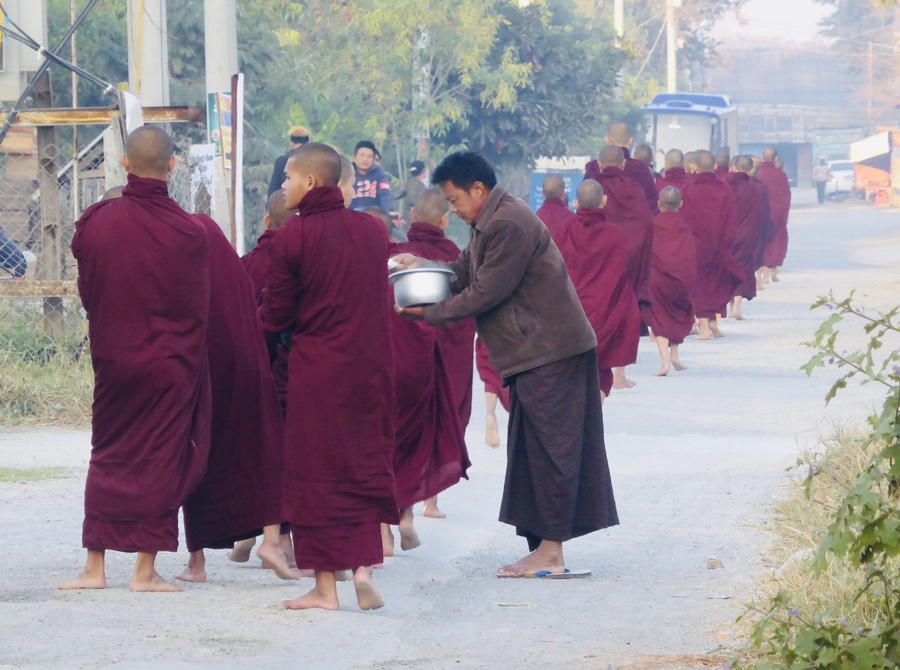
What is Tak Bat, AKA: the Lao Buddhist monks’ alms giving ceremony?
The Buddhist alms giving ceremony dates back to the 14th century. Even more remarkable than a centuries’ old tradition is that many locals take part in this pre-dawn ceremony every day. The alms giving ceremony is a symbiotic ritual in which locals provide alms to the monks for their single daily meal. In return, the alms givers receive good karma points.
What happens during Tak Bat or the alms giving ceremony?
The alms giving process begins in the wee hours of the morning each day (frankly, I consider it the middle of the night). Alms givers get up extra early to prepare their daily gifts for the monks, usually sticky rice. Once prepared, the alms givers take their spot along the road, typically sitting on a very short stool or kneeling.
Around 5:30 a.m., a couple of hundred monks file quietly out of their respective wats (temples) and begin their procession around the city. Each monk carries a single item: a large pot with shoulder strap attached for collecting their alms. As the monks file silently past the roadside alms givers in meditation, the alms givers place a three-finger scoop of sticky rice in each monk’s pot. There is no verbal or physical interaction between the giver or recipient.
The monks continue the procession until they have completed their circuit and arrive back to their home wat. Later, the rice is consumed during their one meal of the day–lunch.
Sadly, this is the part where the wheels are beginning to come off the tradition.
The impact of tourists on the alms giving ceremony
Tourists love this sort of stuff. And tourism boards love tourists. Unfortunately, too many tourists are more concerned with getting the perfect photo op than respecting a religious ceremony. Although there are signs posted, brochures available, and online articles galore explaining the Dos and Don’ts of the alms giving ceremony, many travelers are still ignorant.
Or worse…just downright rude.
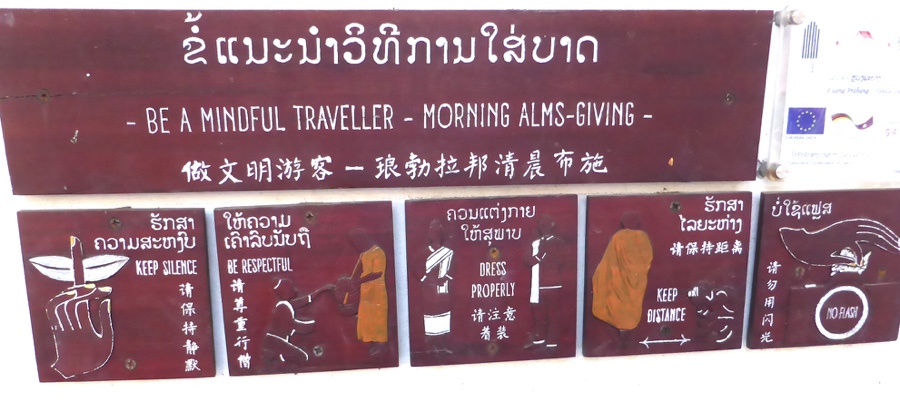
As a result of the circus this ceremony is becoming, many locals and monks no longer want to participate. In order to preserve this beautiful tradition so that Buddhists can participate and respectful travelers can observe, please adhere to the following guidelines and etiquette.
Alms giving guidelines and etiquette
1. Most importantly, DO NOT USE FLASH when taking pictures!
This is the single most obnoxious thing that tourists do, and it is just awful to see. Imagine a line of dozens of monks (many as young as 7 years old) quietly meditating during their pre-dawn walk. When all of sudden, a tourist shoves a camera in their faces and starts snapping pictures with flashes firing in their eyes. Then another tourist does this, then another, and another and another. Flashes begin firing all around and this beautiful, peaceful event is quickly ruined for everybody. Yes, you will be tempted to use flash. I certainly was, because you cannot capture a decent picture in the dark without it. But please resist the temptation.
2. Be quiet.
Whether you are observing or participating, please remain silent during the entire ceremony. Please put your camera and phone in silent mode, and refrain from talking with those in your party.
3. Dress modestly.
Dress as you would if you were visiting a wat or temple. Shoulders and knees should be covered. No shorts, spaghetti strap tops, tank tops, or skimpy clothing.
4. Women should be lower than the monks.
A female alms giver’s head should always be lower than the monk’s head. Therefore, most women will bring a short stool to sit on or will kneel. Men may stand. All alms givers should remove their shoes and socks.
5. Women must not touch the monks under any circumstances.
Enough said.
6. Maintain personal space.
If you are observing the ceremony, then please take a seat across the street from the alms givers. Do not walk up to the monks, stand near the alms givers, or follow the procession.
7. Buy prepared rice from your hotel or guesthouse, not a street vendor.
If you choose to participate, have your hotel prepare the sticky rice the morning of the alms giving.
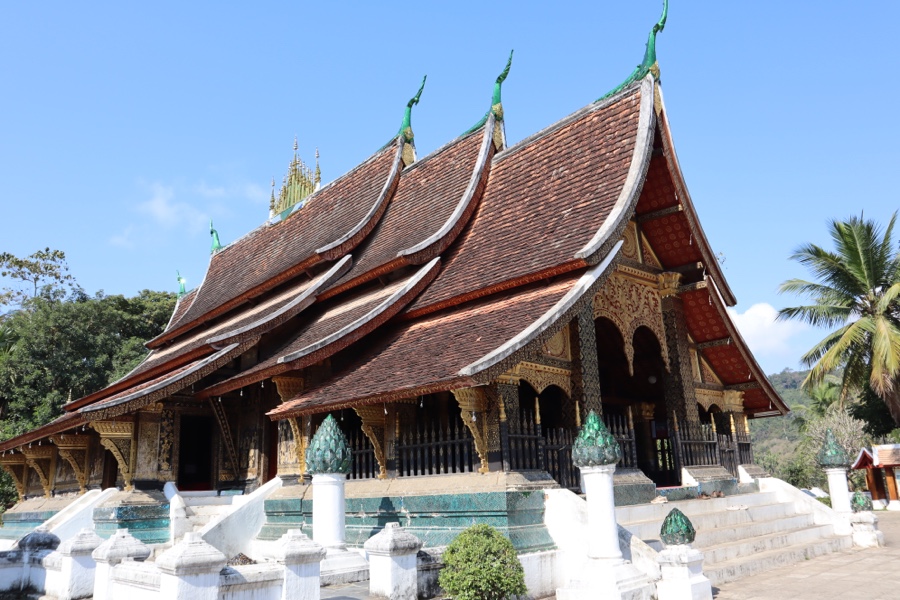
Tips for a better alms giving ceremony experience
1. Observe from a side street.
The main street of Sisavangvong Road is where the busloads of tourists typically congregate. This street feels more like a Mardi Gras parade than a religious procession. If you want to avoid the chaos, go to one of the side streets like Kounxoau Road. You won’t see as many monks, but it will be a more peaceful experience. Or try both locations on different days to see which you prefer.
2. Pick a spot across the street from a street lamp.
The street lamp will light up the monks as they pass by giving you a better opportunity to take pictures without using your flash.
3. Be patient and watch the entire ceremony.
The beginning of the procession will be in total darkness, but as dawn approaches, so does daylight. By the end of the procession, there should be enough natural light for your photos to turn out without your flash.
4. Dress warmly.
Although afternoons can be quite hot in Luang Prabang, mornings range from cool to downright cold. Dress accordingly.
5. Stay in the Old Quarter.
There is nothing better than rolling out of bed and walking a block or two to view the procession. Don’t stay in a location that would require a tuk-tuk or tour bus to get there.
Should you observe or participate in the Tak Bat ceremony?
Finally, you’ll need to decide if you want to just watch or if you want to provide alms to the monks yourself. I saw many signs posted stating that one should not participate if the ceremony is not personally meaningful. In other words, don’t just participate for the photo op. However, other signs and guidelines encouraged tourists to participate if they wanted to, as long as they observed the proper etiquette.
Ultimately, this is a personal decision and the choice is yours.
In our case, we chose to only observe. I felt like our participation would be akin to a non-Christian showing up at our church with a camera and taking communion “for the experience of it.” I imagined a guy with a selfie stick saying, “Hey! Watch me eat this cracker and take a shot of grape juice. Can’t wait to put this on my story!”
For us, it felt more authentic to observe this Buddhist religious tradition rather than inserting ourselves into the middle of it. There is certainly nothing wrong with wanting to provide alms to the monks if you feel so inclined. Whatever you decide, just make sure you are doing it for the right reasons and not just for the photo op.
Luang Prabang has so much to do! Read this for more ideas.

Ready to explore the world? Then check out THE PASSPORT PROJECT and THE ULTIMATE TRAVEL TRACKER to inspire and manage your wanderlust.


Interested in more epic adventures? Check out the following:
- Camping in Antarctica: Everything You Need to Know to Survive
- How to Save Thousands on Your Family’s Galapagos Adventure
- Ten Day Namibia Road Trip: Sand, Seals, and Safari
- How to Plan a Budget Vacation to the Luxurious Maldives
- How to Book an Amazing and Affordable South Africa Safari
- No Regrets: Bungee Jumping in Queenstown, New Zealand
- The Passport Project: A DIY Journey Around the World
Interested in more cultural adventures? Check out following:
- Three Tips for Ethically Visting Myanmar‘s Long-Neck Women
- How to Volunteer at Delhi’s Gurudwara Bangla Sahib Sikh Community Kitchen
- Burial, Cremation, and Reincarnation in Bali
- Learn to Meditate at Truc Lam, Da Lat, Vietnam’s Buddhist Monastery
- Family Travel Idea: Spend the Night with the Embera Puru Indians in Panama
- Don’t be Flashy! Guidelines for Luang Prabang’s Alms Giving Ceremony
- Cambodia‘s Genocide: What I Never Learned in School
PIN IT FOR LATER
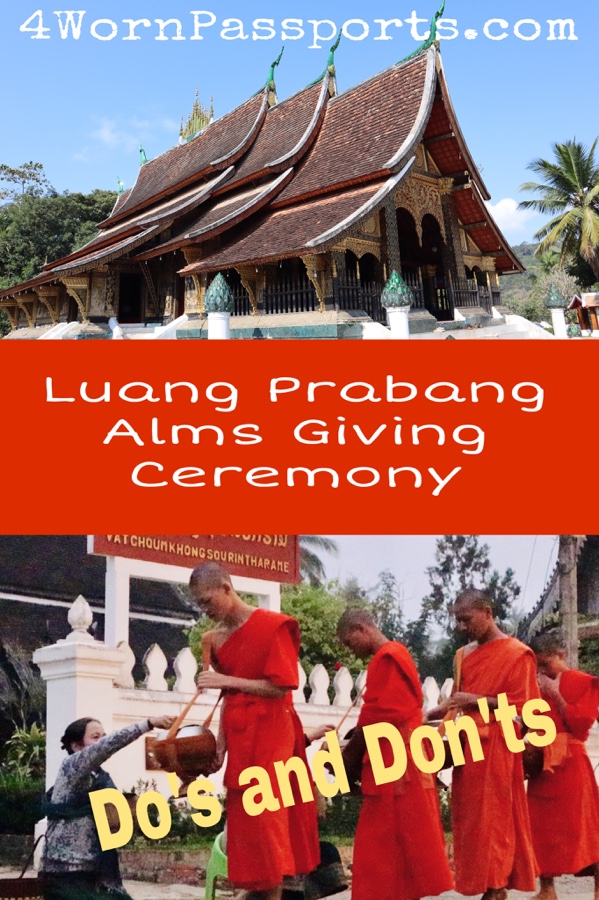
Other articles that may interest you:
Burial, Cremation, and Reincarnation in Bali

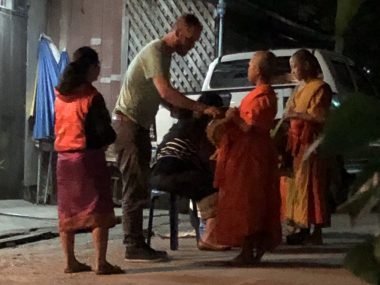
[…] is no shortage of tourists acting like jerks at the morning tak bat ceremony. Be sure to learn the proper Buddhist alms giving etiquette and don’t be one of […]